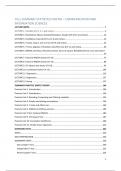College aantekeningen
Complete summary Statistics Premaster CIS + Roadmap all tests
- Vak
- Instelling
- Summary of all Statistics Lectures (Chapter 1 till 15 of the book learning statistics with jamovi- Danielle J. Navarro & David R. Foxcroft). - Summary of all Practice Units - Summary/Roadmap of all tests (!) and all the other important things you need to keep in mind. This is everything...
[Meer zien]



